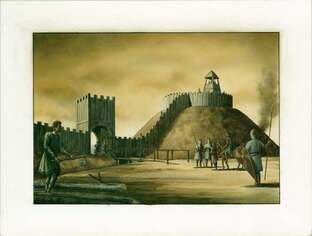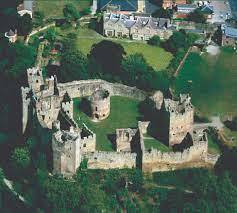Welsh Border Castles
 Motte and bailey design The Welsh border with England was the most heavily fortified frontier in Europe during the Middle Ages. Between 1066 and 1200, hundreds of castles were built there, at least 250 in Herefordshire and Shropshire alone..
Motte and bailey design The Welsh border with England was the most heavily fortified frontier in Europe during the Middle Ages. Between 1066 and 1200, hundreds of castles were built there, at least 250 in Herefordshire and Shropshire alone..The first of these castles were motte and baileys. The motte, an earthen mound with a tower on it that was the home of the local lord, was surrounded by a bailey, an enclosed area that usually had the stables, areas for storage, a chapel, and a well. The walls and buildings were made of wood initially.. After William successfully led the Normans in the 1066 invasion, he had to work quickly to secure his borders, and building with wood was the quickest was to build a fortification.
 The Normans struggled to maintain their grip against sporadic Welsh raids along the border. Their kings granted great powers to the border lordships so they would act as a buffer zone. Powerful feudal families, such as the Mortimers, dug in, building bigger and stronger castles such as the one at Ludlow.
The Normans struggled to maintain their grip against sporadic Welsh raids along the border. Their kings granted great powers to the border lordships so they would act as a buffer zone. Powerful feudal families, such as the Mortimers, dug in, building bigger and stronger castles such as the one at Ludlow. By the end of the 12th century, these border lords began replacing their wooden structures with more permanent stone ones. Stone keeps, some with bed chambers that had fireplaces and windows with dramatic views, replaced the wooden towers. Wooden palisades were replaced with stone curtain walls, which often had stone towers in their corners to improve their defenses. But this transformation was expensive, and where it was not needed, it was not pursued. By the end of the 13th century, Edward I had subdued the Welsh and the need for fortified castles declined. Many of the early motte and baileys were abandoned. Their timber defenses rotted away, leaving only the earthwork mounds. The remaining castles became more comfortable homes with the addition of pleasure gardens and larger doorways and windows on the lower floors.
 Jennifer Bohnhoff is a middle school history teacher and author who lives in the mountains of central New Mexico. She has written one book set in Medieval Europe. You can read more about it here.
Jennifer Bohnhoff is a middle school history teacher and author who lives in the mountains of central New Mexico. She has written one book set in Medieval Europe. You can read more about it here.
Published on April 25, 2021 00:00
No comments have been added yet.



